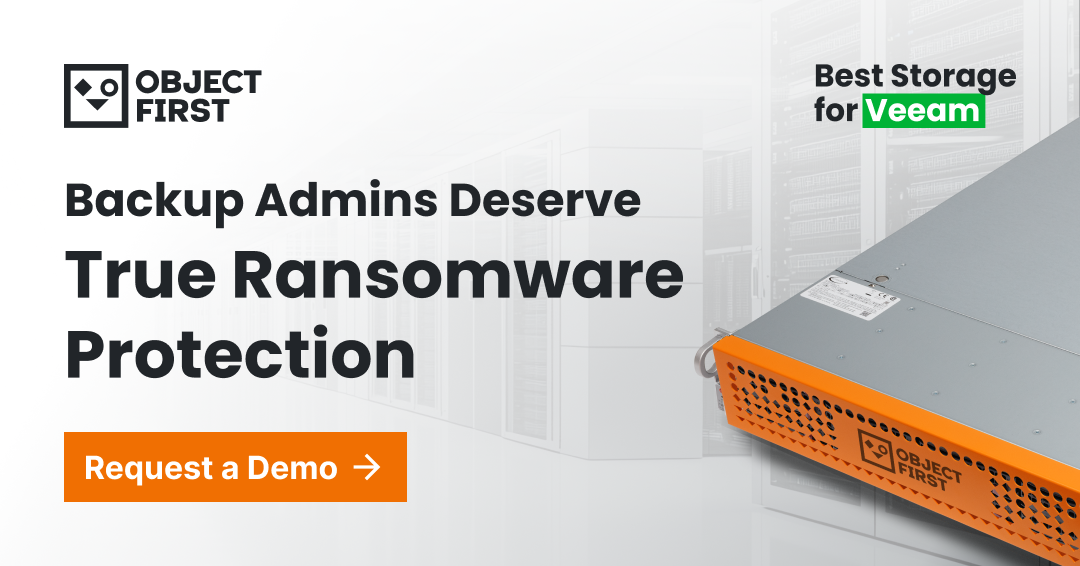Offsite Data Backup: How to Avoid a False Sense of Security
You backed up offsite and believed your data was secure. Then ransomware struck, and your offsite copy turned out to be a perfect replica of the breach.
With 96% of attacks targeting backup systems, hackers know exactly how to corrupt recovery points before replication occurs. That's why offsite data backup, while essential, is no longer fail-safe.
This guide breaks down what offsite backup really means today, shares seven best practices for resilience, and shows how to build a hybrid strategy that ensures reliable recovery.
Key Takeaways
-
Offsite data backup stores critical information in a separate, secure location—defending against ransomware, silent corruption, and localized disasters.
-
Offsite backup isn’t just about storage location—it’s about limiting exposure, reducing lateral movement, and protecting recovery paths.
-
The most resilient strategy pairs immutable on-prem storage with offsite replication—ensuring clean recoveries, compliance, and business continuity when it matters most.
What Is Offsite Data Backup?
Offsite data backup is the practice of storing copies of your data in a separate physical or cloud-based location from where the original data resides in order to protect against localized failures, ransomware, or natural disasters.
Decoupling backup data from primary systems creates an imperative layer of resilience, ensuring that even if production and onsite backups are compromised, recovery remains possible, and your team can maintain business continuity.
Benefits of Offsite Data Backups
Offsite backups do more than ticking a compliance box. When implemented right, they remove single points of failure, mitigate blast radius, and enable faster recovery after even the most catastrophic events.
Here’s what makes them essential for modern organizations:
-
Limit the blast radius of ransomware attacks: By storing backups in an isolated location (separate from the production network), offsite storage makes it significantly harder for ransomware to access, encrypt, or delete backup data, even with escalated privileges.
-
Enable faster local recovery in hybrid environments: With the right setup, organizations can quickly restore on-premises storage while maintaining offsite safety nets (e.g., immutable object storage paired with offsite replication).
-
Ensure business continuity during localized disasters: Whether faced with fire, flood, or hardware failure, an offsite copy guarantees recovery can begin from a clean state—even if your primary environment is completely down.
-
Support compliance and audit-readiness: Many data protection regulations (like GDPR, HIPAA, or NIS2) require secure, tamper-proof backups. Offsite backups, when managed right, provide the separation and verifiability auditors look for.
-
Protect against silent data corruption and software bugs: A properly validated offsite backup allows for comparison, integrity checks, and versioning, so you’re not unknowingly restoring corrupted or compromised data.
-
Reduce reliance on vulnerable cloud configurations: Public cloud misconfigurations are a major cause of backup failures. Offsite storage eliminates dependencies on cloud IAM or shared tenancy risks, especially when physically controlled.
Onsite vs. Offsite Data Backup: What IT Leaders Need to Know
When evaluating a backup strategy, asking where your data is stored is not enough. The real question is how that location affects cyber resilience, recovery speed, and risk exposure.
-
Onsite backups offer fast access and performance but are tightly coupled with your primary environment, making them vulnerable to ransomware, insider threats, and localized disasters.
-
Offsite backups, on the other hand, decouple backup infrastructure from production environments, dramatically reducing the blast radius of an attack, but they come with trade-offs in speed, cost, and complexity.
That's why the most resilient organizations leverage both, utilizing a hybrid model that combines the instant recovery benefits of local immutable storage with the disaster isolation of offsite copies.
Here's a breakdown of the key differences:
| Onsite Backup | Offsite Backup | |
|---|---|---|
| Location | Stored locally, often on the same physical site or network | Stored in a physically separate location, often in the cloud or remote DC |
| Recovery Speed | Fastest recovery (LAN-speed restores, minimal latency) | Dependent on bandwidth; slower without local caching or edge infrastructure |
| Ransomware Exposure | High – if the network is compromised, backups may be accessible | Lower – if isolated correctly (air-gapped, immutable, or zero-access) |
| Disaster Protection | Vulnerable to physical damage (fire, flood, theft, power loss) | Protected against localized events and site-wide failures |
| Cost Structure | High upfront hardware and maintenance costs | Operational expense (OPEX) model, scalable but can add up over time |
| Security Architecture | Often shares credentials and privileges with production systems | Can enforce stricter separation, access control, and audit trails |
| Compliance & Auditing | May be harder to demonstrate tamper-resistance or offsite requirements | Easier to align with NIS2, GDPR, HIPAA, and data retention policies |
| Management Overhead | Easier to manage directly; requires on-prem expertise | May rely on third-party SLAs or cloud visibility tools |
| Silent Corruption Risks | Higher risk if not validated against offsite or versioned snapshots | Can serve as a clean restore baseline with historical versions |
7 Must-Know Offsite Backup Best Practices
Not all offsite data backup solutions are created equal, and simply copying data to another location doesn't guarantee resilience.
To truly protect your business from modern threats, your offsite data backup strategy must follow a set of proven, field-tested best practices.
Here are the ones every IT leader should prioritize:
1. Choose a Secure Offsite Backup Destination
To ensure true resilience, choose a backup destination that enforces immutability, separates backup software from data backup storage, and secures data at every stage—at rest, in transit, and during access.
Look for object storage platforms that support features like S3 Object Lock, encryption by default, and policy-based access controls. The more logically isolated the offsite storage is from your core infrastructure, the harder it is for ransomware or insider threats to reach it.
2. Enforce True Immutability in Offsite Storage
Just because your offsite backups are labeled "immutable" doesn’t mean they actually are. In many cloud environments, immutability is only enforced through permissions or API configurations—making it vulnerable to misconfigurations or compromised credentials.
True immutability in offsite storage means your data is protected at the storage layer, not just the application layer. Look for services that support S3 Object Lock in WORM mode, where backup data becomes undeletable and unchangeable until a fixed retention period expires.
3. Automate Offsite Backup Scheduling and Integrity Checks
Manual workflows are one of the most common failure points in backup pipelines, especially when managing offsite copies. Missed data replication windows, delayed retention policies, and skipped integrity checks often go unnoticed until recovery is on the line.
A resilient offsite strategy automates both the when and the how: automated backups are scheduled policy-first, replicated offsite at predefined intervals, and validated using checksums or hash verification. That means no last-minute manual pushes, no overlooked failures, and no surprises during restore.
4. Test Offsite Disaster Recovery Workflows Regularly
Offsite backups are your final safety net. But unless you’ve tested a real-world restore from your offsite location, you don’t know if it actually works. You should simulate recovery from the offsite copy itself, which can be done by partial file restores, system snapshots, or full-environment failovers.
This validates more than just data—it proves bandwidth, latency, credentials, and security zones are configured for speed and resilience. If your RTO hinges on offsite infrastructure, don’t wait until it’s too late to find out it can’t deliver.
5. Use Geographic Redundancy to Eliminate Single Points of Failure
Storing data offsite doesn’t guarantee it’s out of harm’s way, particularly if all your backups live in the same cloud region or datacenter. True geographic redundancy means replicating backups across distinct physical sites or cloud availability zones with separate risk profiles.
Think beyond “offsite” as a checkbox. Use multi-region replication to distribute risk, avoid correlated outages, and meet compliance standards for regional fault tolerance. It’s one of the simplest ways to harden your disaster recovery posture, and one of the most overlooked.
6. Encrypt Everything: At Rest and In Transit
Offsite backups move your data beyond the trusted boundary of your production network, making encryption non-negotiable. That's why every layer must be protected, including payloads, metadata, snapshots, and control plane interactions.
Use AES-256 for data at rest, TLS 1.2+ for in-transit transfers, and avoid storage providers that treat encryption as a premium add-on. Also, don't forget internal pathways—replication traffic and admin access must be encrypted end-to-end to prevent lateral movement and man-in-the-middle attacks.
7. Segment Backup Infrastructure from Production Systems
Your offsite backup environment must be treated as a separate security domain—not an extension of production. This means physical or virtual segmentation, unique authentication credentials, restricted roles, and dedicated transport channels.
Even if attackers breach your core network, they should hit a wall when they try to move laterally into your offsite backups. The best practice is to implement Zero Trust Data Resilience principles, always assuming breach, enforcing least privilege, and denying all destructive actions—even from trusted users.
Ootbi: The Missing Piece in Your Offsite Backup Strategy
Every offsite backup relies on what comes before it. If the original data isn't immutable, replication just transfers risk downstream.
Therefore, source-level immutability is the foundation of any truly resilient offsite strategy, and without it, your backups are just another potential casualty.
That's why we created Ootbi (Out-of-the-Box Immutability), which delivers secure, simple, and powerful on-premises backup storage for Veeam customers.
Ootbi is secure by design as defined by CISA. It was built around the latest Zero Trust Data Resilience principles, which follow an "Assume Breach" mindset that accepts individuals, devices, and services attempting to access company resources are compromised and should not be trusted.
Download the white paper and learn why Ootbi is the Best Storage for Veeam.
Summary
Offsite data backup protects against ransomware, corruption, and localized failure by storing critical data in a physically or logically separated infrastructure. But without immutability at the source, it’s still vulnerable.
A resilient strategy starts with immutable on-premises object storage and then safely replicates. It’s the only way to ensure clean, compliant recoveries and real business continuity when disaster strikes.


